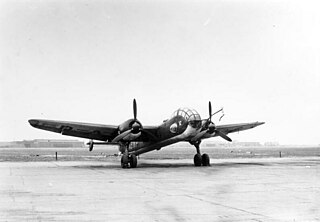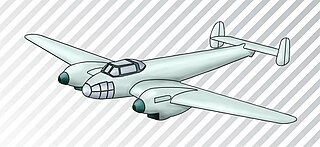| Henschel Hs 127 | |
|---|---|
 | |
| Role | Bomber |
| National origin | Germany |
| Manufacturer | Henschel & Son |
| First flight | 1937 |
| Number built | 2 |
The Henschel Hs 127 was a German bomber that was built as two prototypes, but cancelled without entering mass production.
| Henschel Hs 127 | |
|---|---|
 | |
| Role | Bomber |
| National origin | Germany |
| Manufacturer | Henschel & Son |
| First flight | 1937 |
| Number built | 2 |
The Henschel Hs 127 was a German bomber that was built as two prototypes, but cancelled without entering mass production.
In 1935, the RLM (Reichsluftfahrtministerium - German Ministry of Aviation) published requests for a fast tactical bomber. Junkers, Focke-Wulf, Messerschmitt and Henschel all submitted designs.
According to RLM specifications, the aircraft was to be able to maintain a speed of 500 km/h (313 mph) for 30 minutes, take-off to a height of 20 m (65 ft) in not more than 750 m (2,460 ft), and carry one defensive machine gun and 500–800 kg (1,100-1,760 lb) of bombs. The crew was to consist of a pilot, a bombardier/navigator and a gunner.
Focke-Wulf soon withdrew from participation, so three projects were presented: the future Hs 127, the Junkers Ju 88 and the Messerschmitt Bf 162. Prototypes were ordered of all three, with new Daimler-Benz DB 600 engines to be installed on all three types.
The maiden flight of the Hs 127 V1 was at the end of 1937. The aircraft was smaller and lighter than the Ju 88 and had a very good top speed of 565 km/h (353 mph), but the Ju 88 was chosen because of its bigger bomb load.
In May 1938, the contract for Hs 127 development was cancelled by the RLM and the third prototype was not finished.
The Hs 127 was a low-wing monoplane with monocoque fuselage. Its two-spar wing had an all-metal covering and was equipped with flaps. Its retractable gear had shock-absorbers to facilitate operations from poor airstrips. All three crew members sat in the nose.
Data fromThe warplanes of the Third Reich [1]
General characteristics
Performance
Armament
1,500 kg (3,300 lb) bombload
Related lists

The Henschel Hs 129 was a World War II ground-attack aircraft fielded by the German Luftwaffe. The aircraft saw combat in Tunisia and on the Eastern Front.

The Junkers Ju 388Störtebeker is a World War II German Luftwaffe multi-role aircraft based on the Ju 88 airframe by way of the Ju 188. It differed from its predecessors in being intended for high altitude operation, with design features such as a pressurized cockpit for its crew. The Ju 388 was introduced very late in the war, and production problems along with the deteriorating war conditions meant that few were built.

The Messerschmitt Bf 110, often known unofficially as the Me 110, is a twin-engined Zerstörer, fighter-bomber, and night fighter (Nachtjäger) developed in Nazi Germany in the 1930s and used by the Luftwaffe during World War II. Hermann Göring was a proponent of the Bf 110, believing its heavy armament, speed, and range would make the Bf 110 the Luftwaffe’s premier offensive fighter. Early variants were armed with two MG FF 20 mm cannon, four 7.92 mm MG 17 machine guns, and one 7.92 mm MG 15 machine gun for defence. Development work on an improved type to replace the Bf 110 - the Messerschmitt Me 210 - began before the war started, but its shakedown troubles resulted in the Bf 110 soldiering on until the end of the war in various roles. Its intended replacements, the aforementioned Me 210 and the significantly improved Me 410 Hornisse, never fully replaced the Bf 110.

The Focke-Wulf Fw 187 Falke ("Falcon") was a German aircraft developed in the late 1930s. It was conceived by Kurt Tank as a twin-engine, high-performance fighter, but the Luftwaffe saw no role for the design, perceiving it as intermediate between the Messerschmitt Bf 109 and Bf 110. Later prototypes were adapted to two-seats to compete with the Bf 110 in the heavy fighter (Zerstörer) role, but only nine aircraft were built in total.

The Arado Ar 240 was a German twin-engine, multi-role heavy fighter aircraft, developed for the Luftwaffe during World War II by Arado Flugzeugwerke. Its first flight was in 1940, but problems with the design hampered development, and it remained only marginally stable throughout the prototype phase. The project was eventually cancelled, with the existing airframes used for a variety of test purposes.

The Messerschmitt Me 264 was a long-range strategic bomber developed during World War II for the German Luftwaffe as its main strategic bomber. The design was later selected as Messerschmitt's competitor in the Reichsluftfahrtministerium's Amerikabomber programme, for a strategic bomber capable of attacking New York City from bases in France or the Azores.

The DFS 194 was a rocket-powered aircraft designed by Alexander Lippisch at the Deutsche Forschungsanstalt für Segelflug.

The Junkers Ju 390 was a German long-range derivative of the Junkers Ju 290 aircraft, intended to be used as a heavy transport aircraft, maritime patrol aircraft and long-range bomber. It was one of the aircraft designs submitted for the abortive Amerikabomber project, along with the Messerschmitt Me 264, the Focke-Wulf Ta 400 and the Heinkel He 277.

The Junkers Ju 89 was a heavy bomber designed for the Luftwaffe prior to World War II. Two prototypes were constructed, but the project was abandoned without the aircraft entering production. Elements of its design were incorporated into later Junkers aircraft.

Bomber B was a German military aircraft design competition organised just before the start of World War II to develop a second-generation high-speed bomber for the Luftwaffe. The new designs would be a direct successor to the Schnellbomber philosophy of the Dornier Do 17 and Junkers Ju 88, relying on high speed as its primary defence. Bomber B would be a much larger and more capable aircraft, with range and payload far greater than the Schnellbomber, besting the largest conventional designs then under consideration. The winning design was intended to form the backbone of the Luftwaffe's bomber force, replacing the wide collection of semi-specialized designs then in service. The Reich Air Ministry was so optimistic that more modest projects were generally cancelled; when the project failed the Luftwaffe was left with hopelessly outdated aircraft.

The Junkers Ju 288, originally known within the Junkers firm as the EF 074, was a German bomber project designed during World War II, which only ever flew in prototype form. The first aircraft flew on 29 November 1940; 22 development aircraft were eventually produced.

The Messerschmitt Bf 162 was a light bomber aircraft designed in Germany prior to World War II, which flew only in prototype form.

The Focke-Wulf Fw 191 was a prototype German bomber of World War II, as the Focke-Wulf firm's entry for the Bomber B advanced medium bomber design competition. Two versions were intended to be produced, a twin-engine version using the Junkers Jumo 222 engine and a four-engine variant which was to have used the smaller Daimler-Benz DB 605 engine. The project was eventually abandoned due to technical difficulties with the engines.

The Daimler-Benz DB 600 was a German aircraft engine designed and built before World War II as part of a new generation of German engine technology. It was a liquid-cooled inverted V12 engine, and powered the Messerschmitt Bf 110 and Heinkel He 111 among others.

The Focke-Wulf Fw 57 was a prototype German heavy fighter and fighter-bomber. Prototypes were built in 1936 but never entered production.

The Henschel Hs 130 was a German high-altitude reconnaissance and bomber aircraft developed in World War II. It suffered from various mechanical faults and was never used operationally, only existing as prototype airframes.

The Dornier Do 317 was a prototype German medium bomber of World War II.

The Henschel Hs 124 was a twin-engine heavy fighter, attack aircraft and light bomber designed in Nazi Germany. After two prototypes had been built, work on the project was cancelled.

The Arado Ar 198 was a prototype reconnaissance aircraft, developed by Arado Flugzeugwerke, with backing from the Luftwaffe, who initially preferred it over the Blohm & Voss BV 141 and the Focke-Wulf Fw 189. However, when flight tests were carried out the aircraft performed poorly and did not impress the Luftwaffe. One aircraft was completed in 1938.